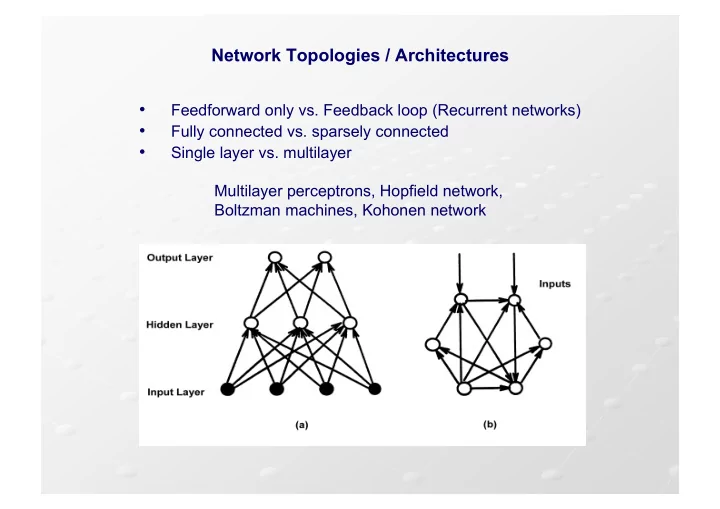

Network Topologies / Architectures • Feedforward only vs. Feedback loop (Recurrent networks) • Fully connected vs. sparsely connected • Single layer vs. multilayer Multilayer perceptrons, Hopfield network, Boltzman machines, Kohonen network (a) A feedforward network and (b) a recurrent network
Classification Problems Given : 1) some “features” ( ) 2) some “classes” ( ) Problem : To classify an “object” according to its features
Example # 1 To classify an “object” as : = “ watermelon ” = “ apple ” = “ orange ” According to the following features : = “ weight ” = “ color ” = “ size ” Example : weight = 80g “ apple ” color = green size = 10 cm ³
Example # 2 Problem : Establish whether a patient got the flu • Classes : { “ flu ” , “ non-flu ” } • (Potential) Features : : Body temperature : Headache ? (yes / no) : Throat is red ? (yes / no / medium) :
Example # 3 Classes = { 0 , 1 } Features = x , y : both taking value in [ 0 , + ∞ [ Idea : Geometric Representation
Neural Networks for Classification A neural network can be used as a classification device . Input ≡ features values Output ≡ class labels Example : 3 features , 2 classes
Thresholds We can get rid of the thresholds associated to neurons by adding an extra unit permanently clamped at -1 . In so doing, thresholds become weights and can be adaptively adjusted during learning.
Simple Perceptrons A network consisting of one layer of M&P neurons connected in a feedforward way (i.e. no lateral or feedback connections). • Capable of “learning” from examples (Rosenblatt) • They suffer from serious computational limitations (Minsky and Papert, 1969)
Decision Regions It’s an area wherein all examples of one class fall . Examples :
Linear Separability A classification problem is said to be linearly separable if the decision regions can be separated by a hyperplane . Example : AND X Y X AND Y 0 0 0 0 1 0 1 0 0 1 1 1
Limitations of Perceptrons It has been shown that perceptrons can only solve linearly separable problems (Minsky and Papert , 1969) . Example : XOR (exclusive OR) X Y X XOR Y 0 0 0 0 1 1 1 0 1 1 1 0
A View of the Role of Units
Convergence of Learning Algorithms • If the problem is linearly separable, then the learning rule converges to an appropriate set of weights in a finite number of steps (Nilsson 1965) • In practice, one does not know whether the problem is linearly separable or not. So decrease η with the number of iterations, letting η 0 . The convergence so obtained is artificial and does not necessarily yield a valid weight vector that will classify all patterns correctly • Some variations of the learning algorithm, e.g. Pocket algorithm, (Gallant, 1986)
Multi–Layer Feedforward Networks • Limitation of simple perceptron: can implement only linearly separable functions • Add “ hidden ” layers between the input and output layer. A network with just one hidden layer can represent any Boolean functions including XOR • Power of multilayer networks was known long ago, but algorithms for training or learning, e.g. back-propagation method, became available only recently (invented several times, popularized in 1986) • Universal approximation power: Two-layer network can approximate any smooth function (Cybenko, 1989; Funahashi, 1989; Hornik, et al.., 1989) • Static (no feedback)
Recommend
More recommend